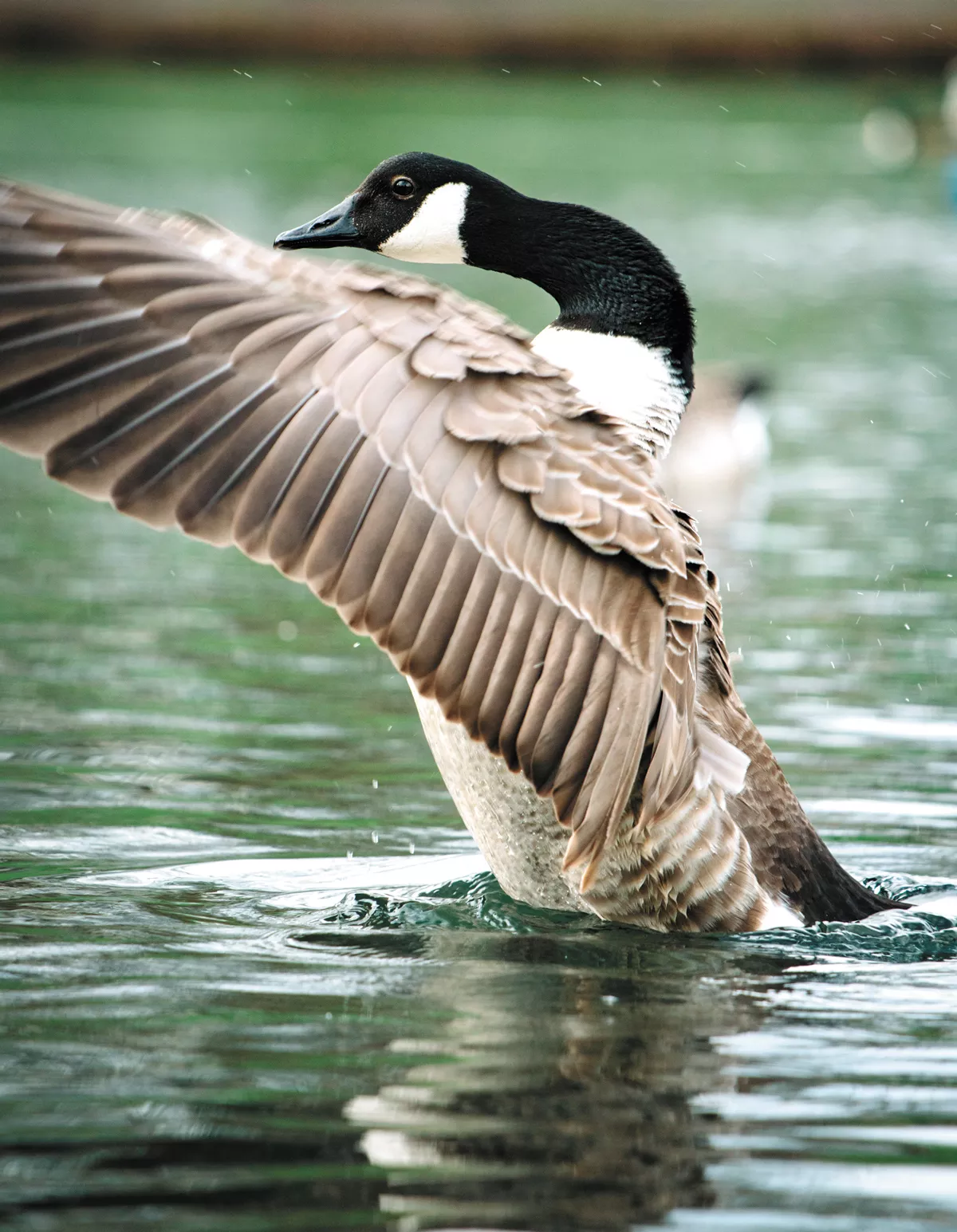The operation begins just before dawn. A caravan of police SUVs storm the entrance to Sandpoint City Beach park, and officers lock the gate behind them. Waiting there, under the street lights, is a woman who knows exactly what's going on: Jane Fritz. A police officer stops her as she approaches. "We're doing maintenance, ma'am, you can't come in," she recalls him saying. It's a ruse.
She knows it's about the geese.
As the sun peeks above the mountains surrounding Lake Pend Oreille, Fritz can barely make out the spectacle happening in the twilight haze behind the gate: Men in blue uniforms wandering hastily through the park, chasing gaggles of geese. Within hours on the morning of June 25, 127 Canada geese are packed into two horse trailers with license plates that say "U.S. GOVERNMENT." The trailers haul the birds far away, but maybe not far enough, to a place where they hopefully won't bother people with their shit.
That's the reason for all of this: Literal bird shit. Western Canada geese — the ones with the white tummies, grayish backs, black necks and a white chin strap — love mowed, grassy areas by water, a trait they unfortunately share with humans. Humans, however, can go to the park bathroom to do their business. Hell, even seagulls can drop their feces in the air freely, without judgment. Canada geese? They're molting in early summer, shedding feathers and unable to fly. So they have no choice but to poop right there in the grass, to the dismay of park lovers everywhere.
And it is happening everywhere. As Canada geese populations continue to grow across North America, cities like Sandpoint are constantly experimenting with new ways to harass the birds and make them go away. They try all kinds of things — dogs, fake coyotes, special lasers only geese can see. Many communities settle for the same plan that Sandpoint ended on recently: Plucking them from their home and leaving them somewhere else.
What horrifies Fritz is Sandpoint's plan for what happens next, if those geese come back.
"Their secret, dark motive," she says, "is to kill these darn birds."

'RACIAL BIGOTRY OF BIRDS'
Eventually, the police let Jane Fritz and some of her friends who have just arrived through the gate. By this point, most of the geese are trapped, and at the mercy of U.S. Department of Agriculture wildlife services officers.
Corralling geese is actually easier than it sounds. Fritz's friend, Chuck Smith, is a local videographer who documented the process that morning and shared the tape with the Inlander. Sandpoint city employees, along with USDA officers, raise their arms at their sides and form a wall — a scary sight, for a bird. Unable to fly, all the geese can do is stick together and speed-walk away from the danger, until suddenly they find themselves unwittingly confined in a pen.
From there, the geese are totally helpless. A man wearing a camouflage hat, flannel shirt and blue jeans hovers above the birds, looking for the next one to grab. The goslings scream and flap their wings furiously. Some try desperately to escape. Others hiss. But they are geese. They can't hurt him, unless he overreacts to the goose's attempts at intimidation and he hurts himself.
One by one, the man grabs a goose, bends its neck back and tucks the head under a wing. As if holding a football, he hands the goose over the pen to someone on the other side. The bird's giant webbed feet dangle hopelessly as it is flipped upside down, scrutinized for its sex, banded and then placed in a trailer with the rest of the birds.
This June was the second time the geese at the park were captured and relocated, and the second time Fritz and Smith were there to witness it. As a journalist, one who has previously written articles for the Inlander, Fritz says she wants to document what she considers to be geese abuse.
"I am not a wacko," Fritz says. "I am a person who cares about wildlife."
Smith is on her side. He calls the geese "regal creatures," like "classy, stately women going out to the opera." It's unsettling to see them treated this way, he says, and while he doesn't see the corralling of geese to be as cruel as Fritz does, he does see it as an injustice. Seagulls and other birds poop at the park, he says, so why are geese singled out?
"It amounts to kind of an aviary rights problem — a racial bigotry of birds," Smith says.
To be clear, Sandpoint has not killed any geese — not yet, at least. To do so, they would need a permit from the U.S. Fish and Wildlife Service, since the birds are protected under the federal Migratory Bird Treaty Act. Sandpoint has applied twice for a permit to relocate geese and then kill the ones that return to the beach — this year asking to euthanize up to 150 birds — but they've thus far been denied the license to kill.
Still, the geese have been a problem at Sandpoint City Beach for decades, says Kim Woodruff, Sandpoint Parks and Recreation director. He says he used to get five or six calls a day complaining about it. There are few public spaces as accessible and as picturesque in the Inland Northwest as Sandpoint City Beach, a grass park surrounded by sandy shores on the north end of Lake Pend Oreille. There are also few places more attractive to Canada geese. The short grass is perfect for both eating and for roaming around in, and the easy access to a large body of water provides an ideal refuge from approaching predators.
Woodruff stresses that he does not want to get rid of all the geese, but only to minimize the amount of poop. He describes himself as a sort of hippie — a virtue in Sandpoint, which is a liberal blue dot in deep red North Idaho. During an interview with the Inlander, he somewhat proudly notes that he doesn't kill bugs in his home and that he doesn't own a gun. He says he's a guy who loves nature and wildlife and the city where he's worked for 34 years.
It's just that a few years ago, he reached a tipping point with these geese. A family member had a work party at the park, and when he got there, it was like walking through a thin layer of mud. Except it was goose poop, inches thick in the grass. He was appalled.
"That's when I knew it was past time of being able to coexist," Woodruff says.
Goose poop can carry E. coli and salmonella, and that can be a real health concern. But realistically, the driving force behind Sandpoint's goose management plan is the fact that people find goose poop unpleasant. It's bad for tourism, and neither Woodruff nor City Administrator Jennifer Stapleton hide that's a major factor in all this.
"The issue with all those non-lethal attempts is that you're not ever really solving the problem. All you're doing is moving that problem someplace else."
Forcing out hundreds of geese from the park, however, is no easy task. They tried coyote statues as decoys, but before long the geese could be seen resting right by the coyote, mockingly. They tried hiring a dog handler to herd the geese off the beach, but eventually, the geese recognized the car as it pulled up, so they simply did their signature upright speed walk over to the shore and splashed into the lake for an easy escape.
Other cities have been more creative. Nelson, B.C, reportedly harasses geese with drones, though it's not unheard of for the geese to fight the drone back. Coeur d'Alene installed lasers at the beach that mess with a goose's eyes. Spokane has focused on making landscape changes, like planting tall grasses in Riverfront Park that are less appealing to geese.
Then there are more lethal measures. Many places "addle" the eggs, killing the embryo chemically but leaving the egg intact so geese don't lay more. The problem for Sandpoint, however, is that while goose nests are likely within a 2- or 3-mile radius of the park, they may not be on Sandpoint property, and that handcuffs the city's ability to take action.
David Drake, an urban wildlife specialist at the University of Wisconsin-Madison, says it's up to each community to decide what they can tolerate. But the surest way to get rid of geese, he says, is to euthanize them by putting the geese into a gas chamber. It may sound cruel, but it's not uncommon. Last year, for instance, Denver killed more than 1,600 geese and donated the meat to charity to feed hungry families.
"The issue with all those non-lethal attempts is that you're not ever really solving the problem," he says. "All you're doing is moving that problem someplace else."
But for some Sandpoint residents, killing geese — or even moving them away — represents a betrayal of the town's identity. One letter to the weekly paper the Sandpoint Reader noted that it's a town that will go so far as to not light fireworks when there's a risk of disturbing osprey nests nearby. "Sandpoint is losing its soul to money. What are we turning into?" it says. Another letter reads: "We all know what this is about: kowtowing to tourists and resort companies like the Marriott."
Fritz wrote several of her own letters to the Reader and the Bonner County Daily Bee that criticize the city for not trying other options first. She argues the city should allow dogs on the beach to deter geese. Or why not contract with a company called Away With Geese that sets up solar-powered lights that bother geese?
She started petitions. She pressed local and federal officials for answers, and never felt satisfied with the response. By late spring this year, she heard that June 25 might be the day of the second goose capture. In the middle of a burgeoning civil rights movement and an ongoing pandemic, she put an ad in the paper that said "END DOMESTIC TERRORISM!" above a picture of roughly two dozen geese calmly resting in the grass. "On June 25, Parks & Rec will bend the necks of 200 geese. Do you care? Call the mayor!" it continued. She guesses her ad is the reason why so many police officers arrived to help with the goose operation this year — maybe they anticipated a protest, too. This year, however, she and Smith were determined to do what they didn't do last year.
Once the half-dozen local and federal officials finished putting the geese in the horse trailers, they want to see where the geese are dropped off. It will require them to follow the trailers full of birds down the highway.
"We wanted to see it from beginning to end," Smith says.
They get in their car, ready to follow the geese. The chase is on.

THE REAL PROBLEM
Fritz and Smith lose the geese before they even leave Sandpoint. But it just so happens that when the two pull into a gas station, they find the pickup trucks carrying the geese in the trailers.
They start tailing them down U.S. Highway 95 towards Coeur d'Alene when another federal truck passes them and slows down. Fritz and Smith assume it's one of the USDA employees, trying to block them from seeing where the geese go. Smith has to speed up and pass the truck in order to catch up.
"It felt like a police chase," Fritz says.
A spokeswoman for USDA wildlife services, Tanya Espinosa, confirms that people opposed to the plan were "tailgating our vehicles" in the two-lane highway and through the dirt roads.
"Our program focuses on the safety of animals, residents and employees," she says in an email. "Unfortunately, harassment and attempts were made to crowd our vehicles."
It ends, anticlimactically, some 90 miles down from Sandpoint, in a lake south of Lake Coeur d'Alene. Fritz and Smith keep their eyes on the wildlife officers, making sure all the geese make it out, filming their every move. Here, the geese are meant to live from now on. If all goes as planned, they will stay. But that's unlikely.
Canada geese weren't always a nuisance to humans. Native to North America, Canada geese are migratory, flying to Canada in the summertime, then back down south to the Lower 48 states in the winter in search of open water. But by the early 20th century, there weren't many around, due largely to overhunting.
By the middle of the century, as part of an effort to rebuild goose populations, humans released Canada geese that had been bred in captivity. Since the 1950s, their populations have skyrocketed, increasing by millions. But because the geese had been captive, they didn't migrate the same way they used to. They could migrate if needed, says Drake, the wildlife specialist. But why would they? Humans can give them everything they need, without the hassle of flying thousands of miles. Those are the geese, called "resident geese," that crowd public parks, golf courses and university campuses.
"It's the way we develop the landscape that allows these animals to really thrive," says Drake.
It's not unique to geese — the same can be said for deer, raccoons and turkeys. We provide the perfect conditions for them to achieve maximum reproduction, then call them a nuisance.
In the mid-2000s, the Fish and Wildlife Service created an environmental impact statement meant to provide more options in dealing with human-goose conflicts, including a permitting process enabling cities to kill geese, and expanding hunting opportunities. But there are 11 subspecies of Canada geese in North America, and seven of those can be found in the Pacific Northwest, says Josh Dooley, a wildlife biologist with the U.S. Fish and Wildlife Service. It creates inherent challenges in goose management on a larger level. While some subspecies are rising in numbers, others are dwindling, which is itself a concern for the federal government.
"That's what's difficult with Canada geese," Dooley says. "Trying to regulate and manage all these different populations."
Western Canada geese, the ones you'll likely see at Sandpoint, have increased in population by 5 or 6 percent in the last 10 years alone, Dooley says. The whole not-migrating-long-distances thing has worked out pretty well. Keep in mind, this is the same species that ingeniously has mastered the flying-V. They're birds who mate for life. They find something that works and stick to it, and that means if they are moved to another location, they're not just going to blindly accept it. Often, even if geese are moved, they will come back to where they're comfortable. Fritz, for one, is eager to point out that if you go to the Sandpoint beach today, you're likely to see geese with bands on their legs, the ones moved just a year ago. If Sandpoint's permit had been approved, they might be dead.
"Unless there's a real change in overall habitat that initially attracted them to that area, it's going to be difficult to keep them out of there in the long-term," Dooley says.
All of this only makes things more of a challenge for a city like Sandpoint that just wants to get rid of bird poop. Move the birds, and they'll come back. Euthanize them, and others might fill the void. Do nothing, and you're covered in shit.
For his part, Woodruff, Sandpoint's parks director, says he's pleased with the goose relocation operations that have been carried out the past two summers. Rarely anymore does he get complaints about fecal matter at the park. He has no idea, however, what happened to the geese dropped off to the south, he says. Once the geese are out of sight, they're out of mind.
That's more than unsettling to Fritz. She worries about what happens once the geese are dropped far away from their home. Do the young die from all the stress? Are they hunted? Is there some other unforeseen impact?
"I don't think anybody really thinks about the long-term consequences to these invasive and abusive actions," she says. "But I do. I care."
For the geese and for the people of Sandpoint, the future is uncertain. When asked if the city will again apply for a permit to euthanize geese, Woodruff won't say. But he insists that whatever happens, it's not out of any malice toward the geese.
He knows the geese are only living in the world humans created.
"We can truly blame ourselves for the situation we're in," Woodruff says. "It's not the geese; it's the people who are the problem."
On that, Fritz can agree.♦











